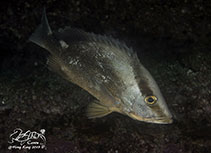| Family: |
Lutjanidae (Snappers), subfamily: Lutjaninae |
| Max. size: |
100 cm TL (male/unsexed); max.weight: 7,910.0 g; max. reported age: 31 years |
| Environment: |
reef-associated; brackish; marine; depth range 12 - 100 m |
| Distribution: |
Indo-West Pacific: Persian Gulf and Arabian Sea to Fiji, north to southern Japan, south to Australia. This species has been frequently misidentified as Lutjanus sanguineus (Ref. 55). There are unsubstantiated reports of this species from off East Africa. |
| Diagnosis: |
Dorsal spines (total): 11-11; Dorsal soft rays (total): 12-14; Anal spines: 3-3; Anal soft rays: 8-9. This species is distinguished by the following characters: body relatively deep; greatest depth 2.2-2.8 in SL; mouth large, maxilla length about equal to distance between bases of
last dorsal- and anal-fin rays; preopercular notch and knob poorly developed; vomerine tooth patch crescentic or triangular, without a medial posterior extension; gill rakers of first gill arch 4-7 + 12-14 = 18-20 (including rudiments); caudal fin truncate. Colour of back and sides red or red-orange, lighter on lower parts; fins reddish; juveniles with a broad, oblique band of brown or black from upper jaw to beginning of dorsal fin, and a prominent black band across caudal peduncle with a pearly white anterior border, similar to L. timorensis but without the black pectoral-fin axil; young also with a series of narrow reddish horizontal lines (sometimes absent) on sides (Ref. 9821, 90102).
Description: Dorsal profile of head steeply sloped; preorbital bone much broader than eye diameter; scale rows on back rising obliquely above lateral line (Ref. 9821). |
| Biology: |
Adults inhabit both coastal and offshore reefs. They tend to be associated with sponge and gorgonian-dominated habitats on the North West Shelf (Ref. 28006), and hard mud areas of the Arafura Sea. In Australia, they frequently form mixed shoals with L. erythropterus. Juveniles tend to inhabit shallow inshore waters and larger fish live in deeper waters (Ref. 27260, 27264). Juveniles also occur in mangrove areas and seagrass beds (Ref. 128523). Feed mainly on fishes, with small amounts of benthic crustaceans, cephalopods and other benthic invertebrates (Ref. 6390). They forage mostly at night (Ref. 6390). Caught mainly with handlines, bottom longlines, and bottom trawls (Ref. 9821). Marketed fresh, dried-salted (Ref. 55) and frozen (Ref. 9987). |
| IUCN Red List Status: |
Least Concern (LC); Date assessed: 28 June 2018 Ref. (130435)
|
| Threat to humans: |
harmless |
Source and more info: www.fishbase.org. For personal, classroom, and other internal use only. Not for publication.

